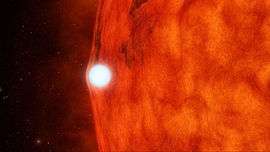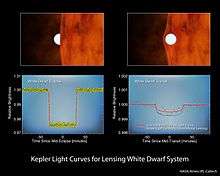KOI-256
 White dwarf companion gravitationally bending the starlight of KOI-256 | |
| Observation data Epoch J2000 Equinox J2000 | |
|---|---|
| Constellation | Cygnus |
| Right ascension | 19h 00m 44.43s |
| Declination | +49° 33′ 55.33″ |
| Characteristics | |
| Evolutionary stage | Red dwarf (M3) |
| Spectral type | V |
| Apparent magnitude (Kepler) | 15.37 |
| Apparent magnitude (J) | 12.701±0.024 |
| Apparent magnitude (H) | 12.001±0.019 |
| Apparent magnitude (Ks) | 11.783±0.023 |
| Apparent magnitude (r) | 15.754 |
| Apparent magnitude (i) | 14.636 |
| Apparent magnitude (z) | 14.059 |
| R−I color index | 1.118 |
| J−H color index | 0.700±0.031 |
| J−K color index | 0.918±0.033 |
| Evolutionary stage | White dwarf (D) |
| Apparent magnitude (Kepler) | 19.45 |
| Astrometry | |
| Distance | 1828 ly (560 pc) |
| Details | |
| Red dwarf | |
| Mass | 0.51±0.16 M☉ |
| Radius | 0.540±0.014 R☉ |
| Temperature | 3450±50 K |
| Metallicity | +0.31±0.10 |
| White dwarf | |
| Mass | 0.592±0.089 M☉ |
| Radius | 0.01345±0.00091 R☉ |
| Temperature | 7100±800 K |
| Other designations | |
| Database references | |
| SIMBAD | data |
| Exoplanet Archive | data |
| KIC | data |
KOI-256 is a double star located in the constellation Cygnus approximately 560 parsecs (1,828 ly) from Earth.[1] While observations by the Kepler spacecraft suggested the system contained a gas giant exoplanet orbiting a red dwarf, later studies determined that KOI-256 was a binary system composed of the red dwarf orbiting a white dwarf.[2][3]
Name

The acronym "KOI" comes from Kepler object of interest and means that the object has been cataloged by the Kepler spacecraft during its search for extrasolar planets using the transit method. The "256" is the number of the object.
Characteristics
Initial observations by the Kepler spacecraft suggested a central red dwarf with a mass of 0.65 M☉, a radius of 1.1 R☉, and a temperature of 3,639 K (3,366 °C; 6,091 °F). Its candidate exoplanet was estimated to have a mass of 14.8 M⊕, a radius of 25.34 R⊕, an orbital period of 1.38 days, a temperature of 1,160 K (890 °C; 1,630 °F), and a semi-major axis of 0.021 astronomical units.[4][5] Further studies by Muirhead et al. (2012) refined the candidate exoplanet parameters to a radius of 5.60±0.76 R⊕, a temperature of 726 K (453 °C; 847 °F), and a semi-major axis of 0.016 AU.[6]
Muirhead et al. (2013) performed additional observations with the Hale Telescope at Palomar Observatory. Using the radial velocity method for exoplanet detection, Muirhead's team found that the red dwarf was wobbling too much to be caused by a planetary mass object, and was more likely being influenced by a white dwarf. Using ultraviolet data from the GALEX spacecraft, it was seen that the red dwarf was significantly active, further suggesting perturbations by a white dwarf. The team re-analyzed Kepler's data, and found that when the white dwarf passed in front of the red dwarf, the red dwarf's light noticeably warped and brightened, an effect called gravitational lensing. While only being slightly larger than the Earth, the white dwarf has such large mass that the physically larger red dwarf orbits around its smaller companion.[2]
With the new observations, the red dwarf was shown to have a mass of 0.51±0.15 M☉, a radius of 0.540±0.014 R☉, and a temperature of 3,450 ± 50 K (3,180 ± 50 °C; 5,750 ± 90 °F). The white dwarf has a mass of 0.592±0.084 M☉, a radius of 0.01345±0.00091 R☉, and a temperature of 7,100 ± 800 K (6,800 ± 800 °C; 12,300 ± 1,400 °F).[7]
References
- ↑ Ayiomamitis, Anthony (28 August 2011). "Differential Photometry - KOI 256 in Cygnus". Perseus.gr. Retrieved 29 August 2015.
- 1 2 "Gravity-Bending Find Leads to Kepler Meeting Einstein". NASA. 4 April 2013. Retrieved 29 August 2015.
- ↑ O'Neill, Ian (4 April 2013). "Kepler Watches White Dwarf Warp Spacetime". Discovery.com. Retrieved 29 August 2015.
- ↑ Borucki, William J.; Koch, David G.; Basri, Gibor; Batalhi, Natalie; Brown, Timothy M.; et al. (July 2011). "Characteristics of Planetary Candidates Observed by Kepler. II. Analysis of the First Four Months of Data". The Astrophysical Journal. 736 (1). 19. arXiv:1102.0541
 . Bibcode:2011ApJ...736...19B. doi:10.1088/0004-637X/736/1/19.
. Bibcode:2011ApJ...736...19B. doi:10.1088/0004-637X/736/1/19. - ↑ Szabó, R.; Szabó, Gy. M.; Dálya, G.; Simon, A. E.; Hodosán, G.; et al. (May 2013). "Multiple planets or exomoons in Kepler hot Jupiter systems with transit timing variations?". Astronomy and Astrophysics. 553. A17. arXiv:1207.7229
 . Bibcode:2013A&A...553A..17S. doi:10.1051/0004-6361/201220132.
. Bibcode:2013A&A...553A..17S. doi:10.1051/0004-6361/201220132. - ↑ Muirhead, Philip S.; Hamren, Katherine; Schlawin, Everett; Rojas-Ayala, Bárbara; Covey, Kevin R.; et al. (May 2012). "Characterizing the Cool Kepler Objects of Interests. New Effective Temperatures, Metallicities, Masses, and Radii of Low-mass Kepler Planet-candidate Host Stars". The Astrophysical Journal Letters. 750 (2). L37. arXiv:1109.1819
 . Bibcode:2012ApJ...750L..37M. doi:10.1088/2041-8205/750/2/L37.
. Bibcode:2012ApJ...750L..37M. doi:10.1088/2041-8205/750/2/L37. - ↑ Muirhead, Philip S.; Vanderburg, Andrew; Shporer, Avi; Becker, Juliette; Swift, Jonathan J.; et al. (April 2013). "Characterizing the Cool KOIs. V. KOI-256: A Mutually Eclipsing Post-common Envelope Binary". The Astrophysical Journal. 767 (2). 111. arXiv:1304.1165
 . Bibcode:2013ApJ...767..111M. doi:10.1088/0004-637X/767/2/111.
. Bibcode:2013ApJ...767..111M. doi:10.1088/0004-637X/767/2/111.